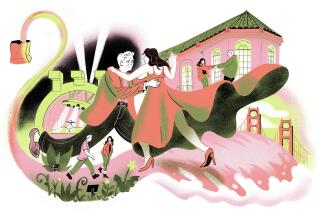BOOK REVIEW : A Tale of Undying Friendship and Love : BUSTER MIDNIGHT’S CAFE <i> by Sandra Dallas</i> Random House $17.95, 277 pages
- Share via
Characters named Effa Commander, Whippy Bird, Pink Varscoe, Jackfish, Pig Face Stenner, and Moon seem to promise a comic novel, but Sandra Dallas reaches for poignancy in her tale of undying friendship and eternal love in Butte, Mont., in the years before and after World War II.
“Buster Midnight’s Cafe” is country music between hard covers, the purportedly true story behind the glamorous career of Marion Street, known to her best friends (Effa and Whippy Bird) as May Anna Kovacks before she was magically transformed from a poor orphan into a Hollywood star. The narrator is Effa, now a spry and articulate septuagenarian determined to set the confused record straight and give us the facts behind the “Love Triangle Murder” that sent the promising prizefighter Buster Midnight to prison for manslaughter after he confessed to shooting Marion Street’s suitor, the 10th-rate actor John Raide.
You need to know that Buster had loved Marion Street not only when she was plain, scrawny May Anna with hair the color of mine runoff, but he remained faithful to her when she “turned out” as Butte’s most glamorous prostitute, a course she embarked upon in order to pay for her dying mother’s medicine. After May Anna got herself discovered by sashaying in front of the newsreel cameras while Roosevelt was campaigning in Butte and went on to become the gun moll of choice in a score of gangster pictures, Buster resigned himself to adoration at a distance. But when Marion needed him, he was there to save her from Raide’s drunken assault.
The rest is history, but all wrong; hopelessly distorted by the yellow press, which did a grand job by itself long before anyone was using the word media.
When the story opens, Effa Commander and Whippy Bird are chatting in the 24-hour Jim Hill Cafe & Cigar Store; two elderly parties remembering better times for the tourists who come in looking for local color. Butte had plenty of that in the old days, but what these snoops want is the lowdown on Marion Street’s career before her debut on the silver screen.
Though there’s already a scurrilous journalist named Hunter Harper dishing it up in his book, “That Hellhole Called Butte,” Effa and Whippy Bird aren’t concerned with the competition. Harper is after a quick buck, while these ladies are looking at posterity.
In the course of their reminiscences, they provide an authentic account of growing up in a raw, depressed, overgrown mining town during the 1930s and ‘40s, taking us dancing and drinking in Butte’s rough speak-easies, inviting us to their wartime weddings, sharing their joys and sorrows as if we were honorary members of the Unholy Three, which is what the whole town called Effa, Whippy Bird and May Anna when they were the town’s wildest kids.
By the second half of the book, Effa and Whippy Bird are grown up and settled down. The narrators observe their old friend’s flourishing career from a distance until she invites them to Hollywood for a riotous, unforgettable week. Marion Street--May Anna to no one but her two old friends--seems to have it all: the round white satin bed, caviar and champagne, even a chauffeur with an on-again off-again British accent, but she’s the same straight shooter she always was, never forgetting that her two bosom buddies knew her when she was working in Nell Nolan’s house in Venus Alley, Butte.
As the author says: “You read about your hookers being mean or else having hearts of gold. I suppose there were both, but the ones me and Whippy Bird knew in Butte were like anybody else.” There you have the essential flavor of “Buster Midnight’s Cafe”: style, tone and lesson in one succinct package.
Next: Carolyn See reviews “Mexican Bolero” by Angeles Mastretta (Viking).
More to Read
Sign up for our Book Club newsletter
Get the latest news, events and more from the Los Angeles Times Book Club, and help us get L.A. reading and talking.
You may occasionally receive promotional content from the Los Angeles Times.










